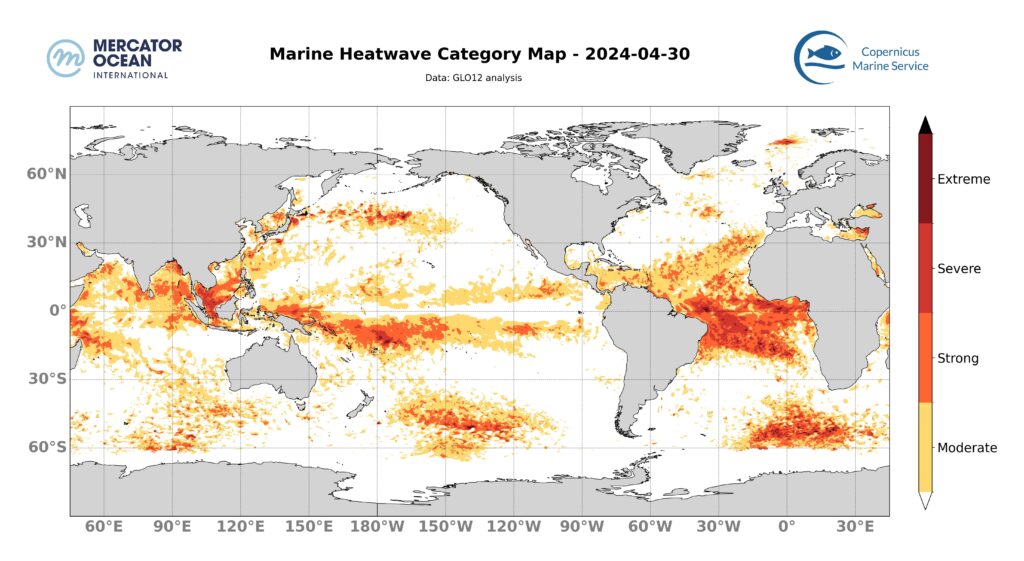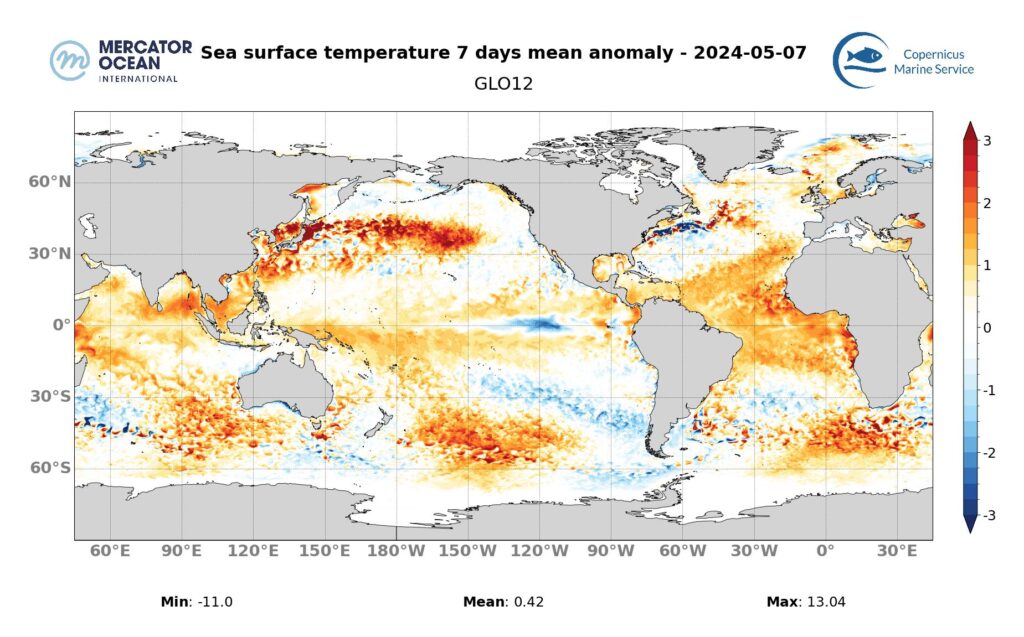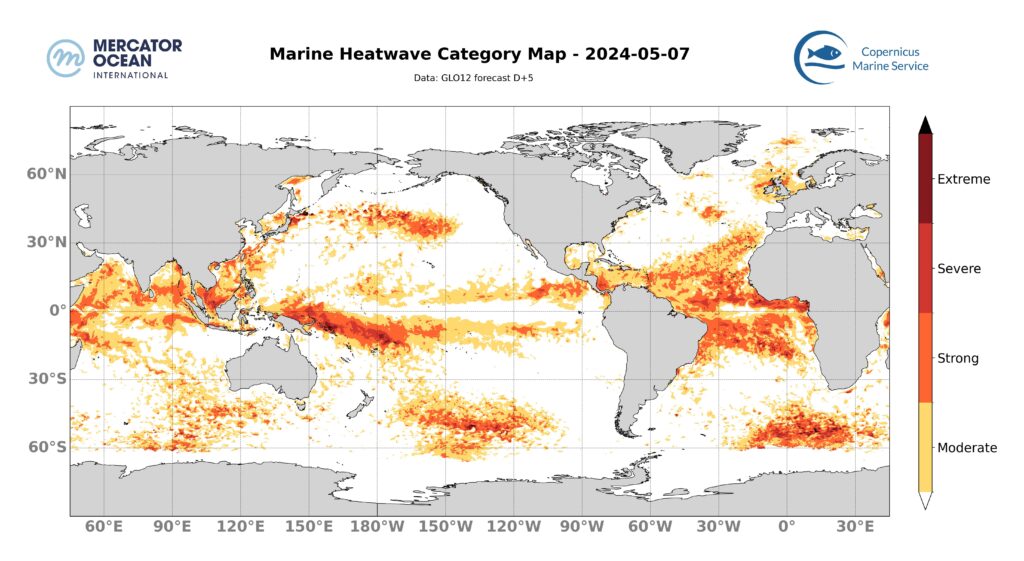Mercator Ocean International (MOi) oceanographers examine marine heatwaves across the global ocean. They analyse a variety of datasets from observations (satellite sea surface temperature maps) to numerical model analyses (assimilating satellite and in situ observations) and derive forecasts for a 7 day period.[1]
Assessment for April 30th
Marine heatwave categories

Zone Europe
Mediterranean Sea
Only the most eastern part of the Mediterranean Sea remains exposed to a marine heatwave of moderate category and locally strong to severe.
Global Ocean
Atlantic Ocean
North Atlantic Ocean –On the North African Atlantic coast, the Moroccan coast to the Strait Gibraltar Strait is no longer affected by a marine heatwave.
North Tropical Atlantic Ocean – In the North Tropical Atlantic and Caribbean Sea, the marine heatwave remains stable in surface area but shows reduced intensity with largely moderate categories and locally strong. In contrast on the equatorial part, strong to severe marine heatwave events are estimatedall across the basin.
South Tropical Atlantic Ocean –In the South Tropical Atlantic and at the equator, the marine heatwave remains stable, with categories ranging from moderate to extreme.
Southern Ocean
The marine heat wave in the Southern Ocean, off the South African coast (between 30°W and 30°E) is stable with categories mostly strong and locally severe.
Pacific Ocean
Tropical Pacific Ocean – In the tropical Pacific Ocean, the marine heatwave to the west of the basin under the equator remains stable in surface areas but decreases in intensity with categories ranging between moderate to severe.
South Pacific, east of New Zealand – The marine heatwave remains stable overall.
South-East Asian Seas
The marine heatwave in the South China Sea intensifies, namely the area covered by strong and severe categories increases. A marine heatwave of category strong remains present north of the coast of Papua New Guinea.
Indian Ocean
In the Arabian Sea, the marine heatwave decreases in intensity and surface area displaying predominantly moderate categories except to the north of Madagascar exposed to strong categories. In the Bay of Bengal and to the west of the Indonesian archipelago, the marine heatwave is gaining in intensity, with strong categories occupying a larger area.
Weekly temperature anomalies

Mediterranean Sea – -0.5°C et 2°C.
North Atlantic Ocean– 0.5°C and 1.5°C.
North Tropical Atlantic Ocean – 0.5°C and 1.5°C.
South Tropical Atlantic Ocean – 1°C et 2°C.
Southern Ocean – -1°C et 3°C.
Tropical Pacific Ocean – 0.5°C and 1°C.
South-East Asian Seas – 0.5°C and 1°C.
South Pacific Ocean – 2°C and 3°C.
Indian Ocean – 0.5°C and 2°C.
Forecast for May 7th

Zone Europe
North East Atlantic region
For the 7th of May, Mercator Ocean International forecasts a marine heatwave of moderate category to locally strong for the oceanic regions surrounding the British islands.
Mediterranean Sea
A situation with no marine heatwave is forecasted for the entire Mediterranean basin.
Global Ocean
Atlantic Ocean
North Atlantic Ocean – MOI forecasts that the marine heatwave on the North African Atlantic coast of Morocco will decrease slightly in intensity but increase in extent.
North Tropical Atlantic Ocean – MOI forecasts that the marine heatwave in the North Tropical Atlantic and Caribbean Sea remains overall stable in extent and gains in intensity, with a larger part exposed to strong category.
South Tropical Atlantic Ocean – In the South Tropical Atlantic, the marine heatwave is forecasted to decrease markedly in intensity, particularly along the equator.
Southern Ocean
The marine heatwave in the Southern Ocean, off South Africa (between 30°W and 30°E) remains stable.
Océan Pacifique
Tropical Pacific Ocean – In the tropical Pacific Ocean, to the west of the basin, the marine heatwave is forecasted to gain in intensity with a larger portion exposed to categories strong to severe.
South Pacific, east of New Zealand – In the South Pacific, East of New Zealand, the marine heatwave will remain stable.
South-East Asian Seas
In the South-East Asian seas, the marine heatwave is decreasing in intensity, with a smaller extent exposed to strong categories.
Indian Ocean
In the Indian Ocean, the marine heatwaves in the Arabian Sea and in the Bay of Bengal are increasing in intensity, with strong categories developing, especially along the African coast.
What are marine heatwaves?
Marine heatwaves (MHW) are extreme rises in ocean temperature for an extended period of time. They can occur at different locations in the ocean, and their magnitude and frequency have increased over the last couple of decades, with harmful impacts on ecosystems, and human activities. According to the latest report released by the Intergovernmental Panel on Climate Change (IPCC AR6 SYR), it is found with high confidence that in the near-term at 1.5°C global warming, the increasing frequency of marine heatwaves will increase risks of biodiversity loss in the oceans, including from mass mortality events.[2]
How are marine heatwaves calculated?
A marine heatwave is a heat episode during which the temperature is significantly higher than a certain threshold for at least 5 consecutive days.

Figure adapted from Hobday et al. (2018)
The seasonally-varying threshold is defined on a daily basis according to a sufficiently long climatic period (in this case 1993-2016). So, for a given place and a given day, knowing all the surface temperatures observed over the last 30 years, a heatwave situation is defined as one where the temperature measured is within 10% of the maximum values observed (i.e. above the 90th quantile, see diagram), for at least 5 consecutive days.
The main characteristics of heatwaves are their duration and intensity. The intensity for a given day corresponds to the value in degrees above the 90th quantile (blue arrow), which can either be calculated as the cumulative intensity throughout the heatwave event, or the maximum intensity.
Heatwaves are categorised on the basis of their deviation from the mean temperature or anomaly (green arrow): a deviation of more than 2 times the difference between the 90th quantile and the mean corresponds to a heatwave in the strong category; a deviation of more than 3 times corresponds to a heatwave in the severe category; and a deviation of more than 4 times corresponds to a heatwave in the extreme category.
[1] Analysis of datasets: SST OSTIA (Copernicus Marine Service), OISST (NOAA), GLO12 (Copernicus Marine Service / Mercator Ocean International), PSY4 (Copernicus Marine Service / Mercator Ocean International), and GLO12 et PSY4 forecasts.
[2] IPCC AR6 SYR chapter 4.3 https://www.ipcc.ch/report/ar6/syr/downloads/report/IPCC_AR6_SYR_LongerReport.pdf
